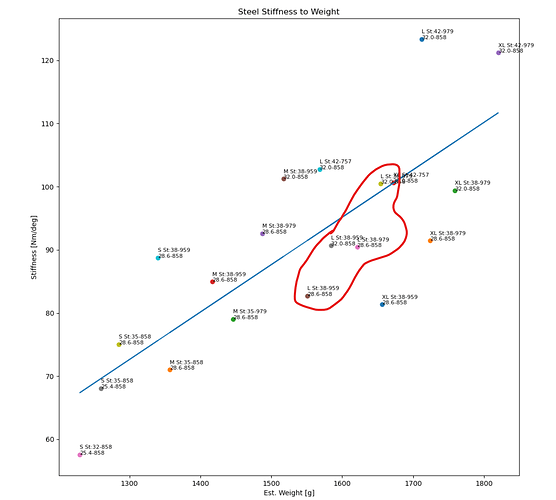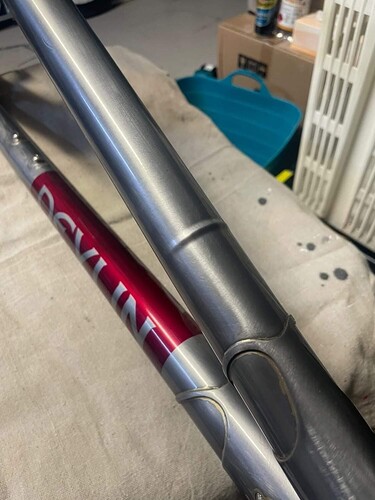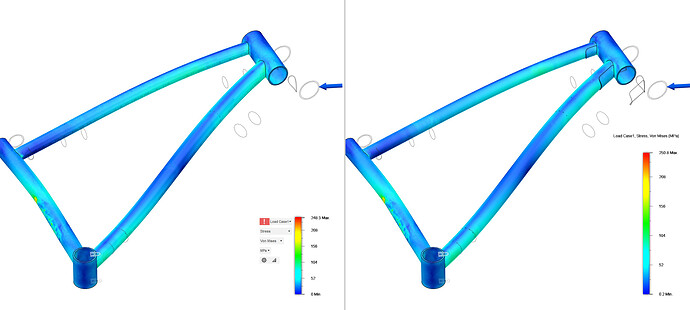All of my mountain bike frames I have made so far have had 31.8mm top tubes, I was thinking about going to a 28.6mm top tube for the next one but I remember seeing PVD had one crack/break on him and he ended up getting custom drawn tubing with a single 1.2mm butt on a .9mm tube.
I can only seem to find 9/6/9 or 8/5/8 butted tubes in this size from the places I usually buy, would I be safe to use this size without a doubler/gusset? for reference I am 82kg/181cm (180#/5’11") and I am a moderately aggressive rider but I don’t tend to go for big hucks/jumps, more natural stuff. I suspect that part of what caused PVD’s tube to fail is the short length of the headtube resulting in a higher load on the top tube but would welcome input from more experienced folks
I use 28.6 9/6/9, 28.6/29.8 1.2/6/9, and 31.8 9/6/9 depending on frame size, rider weight, and type of terrain. I’ve even used an ovalized 25.4 tube on my own hardtail as an experiment and it hasn’t cracked in two years. ![]()
Who makes the 28.6/29.8 1.2/6/9 That sound like it could be good
Use an externally butted seat tube for 27.2, this will have a nice burly 1.2 29.8 wall for the headtube end and more than enough .9 for the seat tube end.
@BikeFabSupply also has heat treated 710mm 9/5/8 28.6 tubes that work very well for modern mountain bikes top tubes.
This is the failure you are referencing: http://www.peterverdone.com/engineering-failures/
I find it odd that it fractured instead of buckled. That might point to a welding or material issue rather than a tube strength problem. Just armchair engineering: if the TT was really seeing stresses beyond its ultimate strength (breaking point), it would have been a pretty noodly frame long before it broke.
We use 28.6TT and 38.1DT up to our ML size (roughly your weight and height + ~460mm reach). For L we step up to 31.8TT and 38.1DT.
I did a front triangle FEA parameter sweep a while back to develop some intuition between the front triangle torsional flex and the tubes and different size bikes. The four points circled in red are probably the most relevant to you (size L w/ different TT’s and DT’s):
- DT diameter dominates
- DT thickness (.5 vs .7) has about the same impact as going from 28.6TT to 31.8TT
- Frame gets stiffer when you size down
Another thing to keep in mind: the force a bike sees is proportional to the mass of the rider and the speed the bike is traveling. So rider and riding style will probably matter more than TT diameters.
We recently built a straight-gauge TI prototype with 44x.9DT and 35x.9TT and it was remarkably stiff, I would argue almost too stiff. We used straight gauge to save some money, but I underestimated the impact of the butting thickness on the stiffness of the bike.
I am curious about what other people have tried, and what they use for their bikes.
Because I use a 38mm DT on the Jester 170mm frame, I use a 35mm 0.9/0.6/0.9 TT. Ideally I’ll get a 1.0/0.7/1.0 made up when I can afford the MOQ. This bike is for going balls out and big so being strong is my main goal. It’s obviously naturally stiif but being such a big travel bike it ends up making a great platform to swing bits off.
For enduro hardtails I do 38.1 1.0-.6-.8 DT and 31.8x.9 TT. On small bikes I’ll do a 35 dt. I like to use straight gauge tt’s for strength (64-61° htas) and also for when the shifter inevitably hits the top tube during a crash or bail.
For xc I’ll go as small as 31.8 dt, 28.6 tt. Depends on what how it’s going to be riden.
Interesting to tube failure for sure! And that it was straight gauge! I’m not saying this is what happened but that location, and all acute angles, are more prone to undercutting while welding which would fit with the location of the fracture. But could just be that VERY long design and short head tube with riding a rigid off drops.
I’ve always used 28.6 on my personal mtbs and have used rigid forks on them. I agree with the flex argument and have only used 31.8’s for big steel frames and big riders. My one customer frame failure was on a drive side chainstay, and the same bike his rigid fork steerer snapped in half. When I fixed that CS I added BMX style gussets on top of the top tube and bottom of the down tube just in case. If anyone will break a frame it’s this dude and so far it’s survived for 5 years.
I would’ve done a straight gauge tube and added a gusset on top, or one like the old Mongoose BMX frames (and what I did on a recent frame). I’m not sure why the gusset hate and skepticism. They’re widely used in BMX, early Bontragers, many small builders, Surly and Salsa…the list goes on.
I’d like to see FEA between using a gusset ala Bontrager style and using thicker butting. In my head the thicker butt works better at distributing stress but I could be wrong. I do think you need a butted TT as the end of the tube will have the strength immediately at the joint but the middle will flex to pull the stress down the tube.
I use 1 1/8 for almost all my bikes. For big/aggro riders I’ll do 31.8. For really huge people (I’ve done plenty of bikes for 300-400# super-clydes) I’ll do 35mm, or even sometimes 38mm.
The external butt seat tube as toptube trick is a good one, I’ve done that plenty of times too.
-Walt
Thanks for spilling the beans everyone. I will give it a whirl on the next frame and see how it goes. I don’t tend to be a breaker of things so I imagine it will be fine.
31.8 top tube, 44 downtube ML+. The 44 downtube was overkill on that frame.
If there’s a butted tube that’s long enough to use I’d use that for sure and would think that’s going to be stronger with less risk of failure. Gussets are good insurance for when you have to use straight gauge or a tube with the perfect butt profile doesn’t exist or fit your design. I have no doubt the ext butt seat tube will be strong enough.
I’d be interested to learn what butted tubing does or doesn’t do in terms of distributing stress and adding flex to the frame.
Yeah, my feeling was the gussets were a band aid solution.
Butting helps by allowing more material at the joint fir strength but then allows the tube to flex through the thinner wall section which reduces the strain right at the joint. If it was straight walled then it the strain is higher at the joint. The flex allows the other end of the tube to move as it needs to with pivoting the tube around the joint itself.
Coming from BMX I had not considered 28.6mm TT for the handful MTB I’ve done so far, but seeing all your long time choices I will most definately consider it. I’ve done butted tubes only 31.8TT/ 35 or 38DT depending on the application ( à la @wzrd )
Most TT failures I’ve seen are from straight gauge tubes, with or without bmx style gussets and one 35mm buckled behind the gusset so I guess depend on the application again.
I don’t think I want to go lower than .9 at the butt for MTB , for my peace of mind, anyone doing .8/.5/.8 TT only?
For those that haven’t seen that post, it’s almost certainly a weld / HAZ failure. In the pictures we can see the crack at the top of the top tube (likely where the crack started) is right at the toe of the weld.
Also worth noting, that bike is quite an extreme use case. Short head tube, high handlebars, rigid fork, and the way he rides it. Lots of stress was on that tube.
But I’m also going to engage my tin-foil hat and note that he has mentioned to me he uses 880 filler for his bikes. (am I just the filler metal nanny on the forum now? I feel like i’ve done this to myself…)
I used a 35mm 8/5/8 on one frame along with my loop bilam sleeve. A pretty hard flat landing caused this crumple. Its right on the toe of the taper. The bilam sleeve and tube combination was so stiff that it pushed the stress down into the tube itself and with the 0.5 section being so close to the end of the sleeve it had not enough room to absorb it in the space of the taper. Two things learned was the transitions need to be softer and longer and the 0.5 is just a little thin for a big bruiser bike.
I’ve dropped the bilam on my mtb’s now and only use them on my top shelf road frame as a special item.
Would clocking your bilams 90* work better in the direction of that TT crumple? Could those loops transition the load better in the vertical plane and the bars work better on the sides similar to welding a gusset on the sides and leaving the center part in welded to avoid a stress riser? Just a thought. I really like your bilams and think it is your signature. That and the tube links.
Yeah for sure but then I lose the aesthetic I was after. I’ve had no issues on other frames but this particular one I made an error in placing the start of the taper at the end of the bilam. So effectively went from 2mm thick (0.8 + 1.2) to 0.5mm. Too much of a drop off.
I have played around with a few different gusset styles on and off in the last year or so. For stiffness and stress concentrations, the FEA did not show any remarkable differences between butt thicknesses, butt lengths (within reason), and gussets under normal loads.
Here is a really quick analysis: (right has two gusset)
These are the generalizations I got from FEA. Feel free to form your own:
- gussets don’t impact torsional stiffness (even the mongoose style)
- choose the end butt thickness for joint strength
- choose the middle butt thickness for desired stiffness
- gussets probably only come into play with large force events: crashes, big drops
For production bikes, my guess is that the gussets are added to prevent the frame from buckling in the ISO tests. I remember hearing something about this in some British bike brand inverview. Maybe someone with some experience with the testing standards can comment.
My concern with gussets is that they can easily create more heat-affected zones, more stress risers, or transmit stress into a worse location.
For regular old hardtails, I am indifferent about gussets. For DJ’s, full suspensions, super slack hardtails, I would probably consider designing a gusset.


